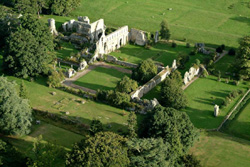 |
 |
 |
 |
 |
 |
 |
|
Byland Abbey: History
Byland Abbey: Buildings
|
External affairs Abbot Roger did not simply confine himself to Byland’s
affairs. He arbitrated on behalf of other Cistercian communities
and was amongst those present at the death of Aelred
of Rievaulx in 1167. Indeed,
it was Roger who anointed Aelred on his deathbed and later applied
a miraculous balsam to his corpse; Roger was able to anoint Aelred’s
entire body with the one remaining drop of this ointment.(34)
Abbot Roger was instrumental in establishing a Cistercian community at Jervaulx [‘Yore-valley’]. The origins of Jervaulx were at Le Fors, where a group of monks sought membership of the Savigniac Order. It was Roger who championed their cause and represented the monks at the Savigniac general chapter of 1147. Following the Cistercians’ absorption of the Savigniac houses, he represented them at the Cistercian General Chapter of 1149. In 1150 the monks of Jervaulx were formally acknowledged as part of the Cistercian family. Upon the instigation of Bernard of Clairvaux, John of Kingston, a monk of Byland who had been one of the original Calder community, led a colony of nine monks from his house to instruct the Fors community in Cistercian customs.(35) John presided as the first abbot and the monastery was directly dependent on Byland. Early problems with the site caused the community to disband, temporarily, from 1154 until 1156, when the monks relocated to the present site at Jervaulx. Abbot
Roger was also active outside the Cistercian Order. For example,
he witnessed Roger de Mowbray’s grant
of land in Hovingham to the Augustinians of St Mary of Newburgh.(36) |
